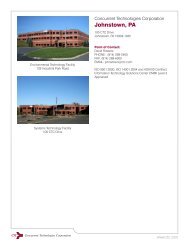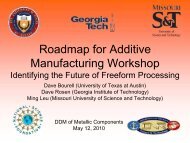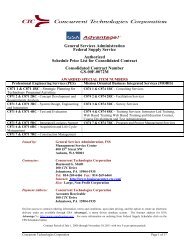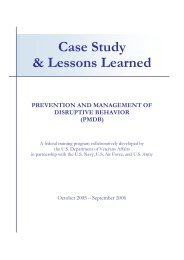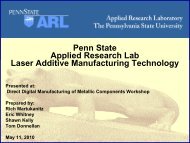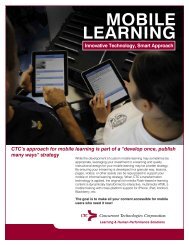Information Security Warfare Systems - CTC Bremerton Instructional ...
Information Security Warfare Systems - CTC Bremerton Instructional ...
Information Security Warfare Systems - CTC Bremerton Instructional ...
You also want an ePaper? Increase the reach of your titles
YUMPU automatically turns print PDFs into web optimized ePapers that Google loves.
ADL SCORM 2004 Demonstration<br />
<strong>Information</strong> <strong>Security</strong> <strong>Warfare</strong> <strong>Systems</strong><br />
(ISWS) Course Conversion<br />
Lessons Learned<br />
May 14, 2004<br />
®<br />
Concurrent<br />
Technologies<br />
Corporation
ADL SCORM 2004 Demonstration: ISWS Course Conversion Lessons Learned<br />
1.0 BACKGROUND<br />
During the summer of 2003, the <strong>Bremerton</strong>, Washington office of Concurrent Technologies<br />
Corporation (<strong>CTC</strong>) converted a CD-ROM based course to a Web-based SCORM 1.2 conformant<br />
course.<br />
The course is part of <strong>Information</strong> <strong>Security</strong> <strong>Warfare</strong> <strong>Systems</strong> (ISWS) training at the National<br />
Defense University (NDU). The content serves as a supplement to a classroom-based course<br />
(either group or lab setting) for network security professionals. It contains approximately 4-5<br />
hours of training on appropriate responses to cyber attacks, including protection, detection,<br />
assessment, recovery, and treatment.<br />
The conversion team explored and documented instructional design and technical issues<br />
associated with converting the course to a SCORM 1.2 conformant Web format. In addition, the<br />
team identified interoperability issues associated with running the course on multiple Learning<br />
Management <strong>Systems</strong> (LMS).<br />
2.0 PROJECT SCOPE<br />
In the spring of 2004, <strong>CTC</strong> undertook a project to convert the previously developed SCORM 1.2<br />
conformant ISWS training to SCORM 2004. In addition to producing SCORM 2004 conformant<br />
content for demonstration purposes, the <strong>CTC</strong> team agreed to analyze and document technical,<br />
instructional, and project management issues noted during the project. Primarily a research and<br />
development task, the goal was to provide the SCORM development community with sample<br />
content illustrating sequencing specification, and a discussion of development issues impacting<br />
the process. As with the previous conversion, one of the objectives was to accomplish the<br />
SCORM 2004 conversion with minimal retrofit to the content itself.<br />
This document contains the discussion of development issues, specifically focusing on lessons<br />
learned during the project. It is intended to provide practical advice about the design and<br />
development of SCORM 2004 conformant training content to instructional designers,<br />
developers, and project managers.<br />
3.0 SCORM 2004 DEVELOPMENT ENVIRONMENT<br />
The <strong>CTC</strong> project team in <strong>Bremerton</strong>, Washington, is representative of project teams in the<br />
current SCORM development community. The team has had successful experience in<br />
developing for previous versions of SCORM for a variety of projects. A case study of one of<br />
these projects, <strong>Systems</strong>-level Oil Spill Prevention Training, is available on ADLNet.<br />
Conversion of the ISWS course was the project team’s first experience in developing for<br />
SCORM 2004, providing a representative example of what a team in the development<br />
community might experience when first encountering the 2004 specification, whether for the<br />
purpose of converting existing content or creating new content.<br />
While this document outlines the experience of one development team for the benefit of others, it<br />
should be noted that the environment necessary to support the delivery of SCORM 2004<br />
<strong>CTC</strong> <strong>Bremerton</strong>, May 14, 2004 2
ADL SCORM 2004 Demonstration: ISWS Course Conversion Lessons Learned<br />
conformant content is still evolving. Consequently, no immediate, sweeping impact is expected<br />
in the SCORM development community. Compatible LMSs are still maturing at the time of this<br />
project, and when SCORM 2004 conformant LMSs are released, it is anticipated that they will<br />
have the capability to support previous versions of SCORM. However, it is reasonable to expect<br />
that many organizations, responding to business needs over time, will want to convert existing<br />
training content to be SCORM 2004 conformant.<br />
4.0 DESIGN AND DEVELOPMENT PROCESS<br />
For this project, the development team slightly modified their standard design and development<br />
process. The scope of work specified the existing training content, which eliminated the need for<br />
some of the usual analysis and design activities concerning audience, content, and context. The<br />
focus was on modifying the instructional design of the SCORM 1.2 version in order to benefit<br />
from the capabilities of sequencing in SCORM 2004.<br />
<strong>Instructional</strong> design and development followed an iterative cycle. The development followed the<br />
requirements outlined in the instructional design. This design was reviewed and revised at<br />
several points in the process, impacting the development. At each of these points, increased<br />
understanding of SCORM 2004 allowed for quality improvement and refining of the product.<br />
Since this project converted existing content, the manifest was the focus of the development<br />
effort. The SCORM 2004 documentation was the main guide; ADL team members supplied<br />
additional expertise as needed. A content-free prototype, using placeholders for the SCOs and<br />
Assets, was created to test the sequencing outlined in the manifest. SCOs and Assets containing<br />
the content were developed independently and later mapped to the completed manifest. The<br />
entire training package was then tested and refined into a final version.<br />
5.0 LESSONS LEARNED<br />
The lessons learned are presented in an order that reflects the design and development process<br />
followed during the project.<br />
1. No matter what their role, all team members should know and understand issues related to<br />
all parts of the design and development process.<br />
This may appear obvious, as it also applies to projects that aren’t designed to SCORM.<br />
However, understanding the issues related to designing and developing for SCORM is especially<br />
critical to instructional integrity because SCORM defines a set of requirements previously left to<br />
individual organizations, affecting both design and development. <strong>Instructional</strong> designers need a<br />
working knowledge of the technical capabilities of SCORM and the relevant LMS(s) in order to<br />
create activities that will work in those environments. Developers have to become more<br />
involved in the design, in order to provide expertise and suggestions for functionality. Designing<br />
and developing to SCORM 2004 can vary the way resources are allocated to a project, requiring<br />
project managers to understand how SCORM requirements can impact cost and schedule. For<br />
instance, more time tends to be required to design context-neutral pieces of content in<br />
conjunction with pieces that add the necessary context to tie a program together.<br />
<strong>CTC</strong> <strong>Bremerton</strong>, May 14, 2004 3
ADL SCORM 2004 Demonstration: ISWS Course Conversion Lessons Learned<br />
2. Content examples are an efficient tool for learning and assimilating SCORM, particularly<br />
the more complicated aspects like sequencing. They can also serve to jump-start the<br />
development process by providing source code.<br />
Before beginning the project, the project team reviewed the SCORM 2004 Photoshop Examples<br />
Version 1.0 available on ADLNet and another content example demonstrated at PlugFest 8. The<br />
examples demonstrated the different possibilities for sequencing and provided code that could be<br />
dissected for greater understanding of how sequencing works. Viewing and discussing the<br />
examples also led to a deeper understanding of the ways SCORM can be used. For instance, the<br />
team noted that any content that didn’t need to communicate with the LMS defaulted to being an<br />
Asset, resulting in fewer SCOs.<br />
Working through the content examples as a group prompted solid discussion about the content<br />
organization of the ISWS course, resulting in the definition of basic sequencing rules and an<br />
activity tree. The content examples also established a basis for the design of the manifest.<br />
The creation of more content examples and sequencing models geared towards the development<br />
community is anticipated. As a library of models and examples emerges, and developers find it<br />
easy to adapt a wide variety of existing code to their own needs, new applications of SCORM<br />
2004 will proliferate in the development community.<br />
3. Determining the course structure is a collaborative process that starts with logical rules<br />
and gradually incorporates the technical requirements related to SCORM.<br />
Drawing from their previous design and development experience and the experience with the<br />
SCORM 2004 content examples, the project team developed the ISWS course in a series of<br />
iterations. Solid instructional design was the first consideration for the organization of the<br />
content. The next consideration was how the learner would experience that content, dictating<br />
how the pieces of content would interact with each other. At this point, it was necessary to start<br />
examining the available sequencing options and defining SCOs and Assets.<br />
In essence, the activity tree became a storyboard for sequencing. At the beginning of the project,<br />
the team thought two versions of the course activity tree should be developed. One would<br />
contain the logical structure and rules and would be the activity tree the project team would agree<br />
on and work from. It would also be used to communicate with clients and stakeholders and<br />
would be included in design documentation. The second version of the activity tree would take<br />
the logical rules and translate them into the technical rules and structure required by SCORM. It<br />
was thought that this activity tree would be used primarily for development, but could also be<br />
included in design documentation, depending on the requirements of the project.<br />
As development progressed, however, the team realized that the manifest itself really became the<br />
documentation, and reference was rarely made to the technical activity tree. So while the logical<br />
activity tree still has value, one that defines all the technical rules may not be necessary.<br />
Nevertheless, a technical activity tree is a useful learning tool for developers and has therefore<br />
been included as a supplement to this document.<br />
<strong>CTC</strong> <strong>Bremerton</strong>, May 14, 2004 4
ADL SCORM 2004 Demonstration: ISWS Course Conversion Lessons Learned<br />
Definition of the technical rules, through the manifest or an activity tree, may necessitate review<br />
of or changes to the logical rules. For the ISWS course, several iterations were required before<br />
the project team felt that they met both the intended instructional design and the functional<br />
requirements of SCORM. The resulting activity trees are included at the end of this document.<br />
4. While the whole team needs a solid understanding of the SCORM specification, the<br />
instructional designers and developers in particular need to collaborate very closely, right<br />
from the beginning of the design phase.<br />
The team repeatedly discussed the question of how thoroughly instructional designers need to<br />
understand the technical rules related to sequencing and SCORM 2004. After developing the<br />
first iteration of the activity tree, the perception was that instructional designers need to have a<br />
comprehensive knowledge of the functions and applications of sequencing rules. Later on, it<br />
appeared to be possible for instructional designers to simply define logical rules in natural<br />
language and hand them off to the developers, who would translate them into technical<br />
sequencing rules.<br />
The general consensus by the end of the project was that an early and healthy collaboration needs<br />
to be established between instructional designers and developers, much as in any design and<br />
development project. From the instructional design perspective, the level of technical know-how<br />
needed to design for SCORM 2004 shouldn’t be any different than the level needed to design for<br />
other delivery methods. For example, in writing a video script, instructional designers need to<br />
understand basic camera angles, editing transitions, and other technical skills related to video<br />
work, even if they won’t be shooting or editing the video themselves. An understanding of how<br />
the developer will work with the content is necessary for an effective instructional design. The<br />
greater this knowledge is, the more efficiencies are likely to be gained.<br />
From the development perspective, including developers in the design phase and encouraging<br />
their input on how to use the media, is already standard in a progressive ISD team environment.<br />
The conclusion was that this is especially crucial with SCORM 2004, as experienced developers<br />
will understand the complexities of sequencing. If they are in close communication with<br />
instructional designers, they can influence the design decisions that will drive the use of the<br />
specification.<br />
Eventually, tools that bridge the gap between instructional design and the technical requirements<br />
of SCORM may serve the same purpose, but in the meantime, collaboration from the early stages<br />
of design may result in significant efficiencies.<br />
5. Taxonomies can be designed to increase potential flexibility and reusability.<br />
ADL has purposefully refrained from referring to course structure using terms like “modules,”<br />
“lessons,” or “sections.” This gives designers the flexibility in structuring and naming<br />
components of courses. It also allows the context-neutral content to be reassembled in a number<br />
of different structures. This approach is demonstrated in ISWS, driven by the goal of having<br />
smaller pieces of content and more flexibility in the way the pieces could be potentially be<br />
reused. The naming conventions used in the ISWS taxonomy refer to the content itself, using<br />
<strong>CTC</strong> <strong>Bremerton</strong>, May 14, 2004 5
ADL SCORM 2004 Demonstration: ISWS Course Conversion Lessons Learned<br />
terms such as “ISWS,” “Attack Class,” and “Attack.” Consequently, a piece of content that was<br />
part of a lesson in this course could be reused as part of a module, a quiz, or a section in another<br />
course. The structure of this taxonomy is shown in the activity tree.<br />
6. To take full advantage of sequencing functionalities in SCORM 2004, content needs to be<br />
as granular as possible, though any redesign to achieve this in a conversion project will mean<br />
additional development costs.<br />
During the design of the ISWS course to the SCORM 2004 specification, the project team grew<br />
to understand the flexibility that sequencing provided. In contrast to the SCORM 1.2 version,<br />
the SCORM 2004 version was redesigned to have fewer SCOs and more Assets, providing for<br />
increased reusability. The only SCOs in the training content consist of test questions, which<br />
must communicate with the LMS to track learner performance.<br />
Redevelopment of the SCOs and Assets to accomplish this fuller use of sequencing requires<br />
additional development resources. In addition, having more pieces of content creates more effort<br />
for the development of metadata and the manifest. Such decisions should be driven by business<br />
need.<br />
7. Objectives, while responsible for providing structure to the course instructional design and<br />
the learner experience, can also function as technical requirements.<br />
With SCORM 2004, objectives can become critical to sequencing and navigation. In non-<br />
SCORM 2004 content, the objective would normally guide the development of the content and<br />
assessment items, but remain essentially a reference point for the instructional design. In<br />
SCORM 2004 development, they may be used as milestones critical to tracking student progress.<br />
In this case, if the sequencing model dictates that the satisfaction of an instructional objective<br />
signals completion, the objective itself has a technical role to play in the manifest.<br />
There is no requirement for instructional and technical objectives to match. In fact, in this<br />
conversion, the stated learner objectives are different from the technical objectives that track<br />
learner progress. This is a function of the retrofit. In the creation of new training, instructional<br />
soundness will result from technical objectives that are a direct reflection of instructional<br />
objectives.<br />
8. The learning curve for sequencing is significant, even for those experienced in previous<br />
versions of SCORM.<br />
Powerful capabilities come at the price of increased complexity. It took time to not only<br />
understand the sequencing rules, but how they are applied and interact with each other and the<br />
LMS. Much of the terminology, which is based on Boolean logic, was new to several team<br />
members. As with any learning curve, development will become increasingly efficient as these<br />
concepts are mastered. It’s expected that tools will evolve to assist in the development process.<br />
<strong>CTC</strong> <strong>Bremerton</strong>, May 14, 2004 6
ADL SCORM 2004 Demonstration: ISWS Course Conversion Lessons Learned<br />
9. Adding context to otherwise context-neutral content requires ingenuity.<br />
During the conversion, the SCOs and Assets for the ISWS course were broken into small, almost<br />
completely context-neutral pieces of content, containing no information related to the course<br />
structure. In addition, many of the Assets are reused at multiple points within the ISWS course.<br />
Consequently, the directory structure became the default mechanism for providing feedback<br />
about a learner’s location in the course.<br />
Since no SCORM 2004 conformant LMSs were available at the time of this conversion project,<br />
the product was tested in the ADL Sample Run-Time Environment (RTE). The RTE does not<br />
provide highlighting, bolding, or any other indication within the directory structure itself that<br />
would alert learners to their location in the training. To add to the problem, every time learners<br />
click on an item in the directory structure, the directory refreshes back to the top. In addition, if<br />
learners satisfy an objective during the pretest, they won’t see the related training. The original<br />
design called for the titles of the satisfied material to be displayed in the directory structure, but<br />
grayed out. This was intended to provide the learners with the overall content structure.<br />
However, sequencing functionality did not allow for items to be grayed out – they had to<br />
disappear entirely. As LMS vendors develop SCORM 2004 conformant products,<br />
redevelopment of the manifest may be necessary in order to accommodate navigation differences<br />
between LMSs.<br />
The result of these situations is understandable confusion for learners who do not already<br />
understand the content organization, or those who choose a non-linear path through the training.<br />
In the case of the ISWS course, the challenge of providing context was compounded by the fact<br />
that several of the Assets were reused within the course. While this demonstrates true<br />
reusability, it added to the confusion.<br />
In an effort to provide context, two strategies were employed. First, a new course introduction<br />
was developed to explain how the course works and list all the content covered. Learners may<br />
return to that introduction at any time to review the entire content list. Second, titles were added<br />
to the onscreen presentation of the SCOs and Assets by calling parameters from the manifest.<br />
These “dynamic titles” display the content hierarchy directly in the content. The titles were not<br />
part of the original design, but during testing it became apparent that the lack of context<br />
detracted from the quality of the training. Consequently, the necessary resources were applied to<br />
add the parameters.<br />
10. Getting the exact sequencing behavior desired may take a little creativity.<br />
The instructional design required learners to complete the introduction upon entering the course.<br />
The introduction consists of two parts – an explanation of how the course works, and a list of the<br />
content. The project team had determined that learners needed to be able to return to the<br />
introduction at any point. This created a bit of a challenge as the sequencing rules did not allow<br />
learners to easily return to the required introduction once it had been completed. The solution<br />
was to add a duplicate introduction to the content cluster that is automatically skipped, but still<br />
available to learners as an item in the directory structure.<br />
<strong>CTC</strong> <strong>Bremerton</strong>, May 14, 2004 7
ADL SCORM 2004 Demonstration: ISWS Course Conversion Lessons Learned<br />
11. Content-free prototypes provide value by creating efficiencies in the development of new<br />
sequencing strategies.<br />
The project team decided to create a content-free prototype to test the SCORM 2004 manifest.<br />
The addition of sequencing added a great deal of complexity and it was desirable to separate it<br />
initially from the content. Thus, content-free placeholders were used in the initial versions of the<br />
product.<br />
The process turned out to be very practical and resulted in a number of efficiencies. First of all,<br />
it allowed the developers to focus on the manifest without complications from the content. A<br />
side effect was a reduction in the learning time for sequencing and navigation. Because the<br />
content-free SCOs and Assets were simple html pages, there was also a significant reduction in<br />
the development time required for testing and quality assurance. Once the content was added,<br />
the testing and quality assurance time associated with the manifest increased dramatically.<br />
The manifest is a reflection of the instructional design in the activity tree. That being noted, if an<br />
organization develops sequencing models, the benefits of content-free prototypes would diminish<br />
as bugs are worked out of the system. Those who choose to work with content-free prototypes<br />
should also allow for sufficient testing of the product with the content, which can have its own<br />
issues.<br />
12. <strong>Instructional</strong> designers and developers can work in parallel.<br />
Once the initial course structure is created, and the sequencing strategy defined, it’s possible for<br />
instructional designers and developers to start working in parallel. For example, while<br />
instructional designers are writing the content, developers can be developing the manifest and<br />
creating and testing a content-free prototype.<br />
13. Navigation is no longer entirely at the discretion of the development team, and<br />
consideration must be taken to ensure learners have a satisfying experience.<br />
SCORM 2004 has a significant impact on end users, compared to previous versions where<br />
SCORM was relatively transparent to the learner. Historically, developers of computer-based<br />
training have designed and controlled the way in which a learner navigates through a course.<br />
With sequencing and SCORM 2004, much of the navigation is controlled by the LMS. SCORM<br />
does not define how this is to be done, and so the same training may be displayed very<br />
differently in different LMSs. It is reasonable to predict that navigational standards will be<br />
developed in the future, but until that time, developers of SCORM conformant courses must pay<br />
particular attention to navigational issues to ensure the learners both context and a smooth<br />
navigational experience. If teams are developing to a known and familiar LMS(s), this could be<br />
relatively simple. It will grow more complex as the number of LMSs to be designed for<br />
increases, or when content must be designed but the LMS is unknown.<br />
Conversion of pre-existing content may require a retrofit of navigation in order to prevent learner<br />
confusion. An objective of this particular conversion was to minimize alterations to the original<br />
content. This resulted in two navigational schemes: the one already incorporated into the SCOs,<br />
<strong>CTC</strong> <strong>Bremerton</strong>, May 14, 2004 8
ADL SCORM 2004 Demonstration: ISWS Course Conversion Lessons Learned<br />
and the one in the RTE. User testing revealed the criticality of coping with this issue. A<br />
workaround was created for this particular project, but project teams will want to address the<br />
interaction of dual navigational schemes early in the process. It is not recommended that<br />
navigation internal to SCOs be eliminated altogether, because this navigation frequently provides<br />
options for interactivity and gives the project team more control over the user’s experience.<br />
14. Training should be designed and developed to the LMS(s), not the RTE.<br />
The RTE is an extremely useful tool developers can use to test the operation of their code, but its<br />
purpose is not to simulate an LMS. Since many elements, such as interface and navigational<br />
components, are controlled by the LMS, developers should be careful to design for and test these<br />
elements in the relevant LMS(s).<br />
15. The return on investment (ROI) associated with sequencing will likely come more from<br />
the flexibility and capabilities that sequencing can provide, rather than from an actual costsavings.<br />
The level of effort associated with sequencing is significant. Development time is increased any<br />
time media becomes more complex. The project team found that the ROI inherent to the<br />
previous ISWS SCORM 1.2 version was readily apparent, as it was derived from the reusability<br />
of the content. The majority of development time was spent on the SCOs and Assets. In<br />
contrast, a larger proportion of the development time for the SCORM 2004 version was spent<br />
building and testing the manifest. The sequencing that can be built into a manifest increases<br />
flexibility, options, and allows the implementation of more complicated designs. However, it<br />
also results in a manifest containing a higher ratio of code to actual course content than previous<br />
versions of SCORM. Rather than expecting a development cost savings, the payback from<br />
added complexity should be assessed from other measures, such as training efficiencies, the<br />
meeting of training requirements, or increased training effectiveness. It should also be noted that<br />
some clients or organizations might not desire complex sequencing strategies.<br />
There are many factors that influence the ROI on sequencing. For this particular project, the<br />
learning curve increased the development time. As project teams become more experienced in<br />
sequencing, and development tools are more readily available, that learning curve will gradually<br />
diminish. Another influencing factor is the potential for reuse of a manifest, or portions of a<br />
manifest. Organizations that borrow or create sequencing models are likely to reap a much<br />
higher return on their development efforts.<br />
6.0 SUMMARY<br />
The SCORM 2004 sequencing specification is a robust tool for designers and developers of<br />
instructional training content. A simple conversion from SCORM 1.2 to SCORM 2004, without<br />
applying sequencing, would be fairly straightforward. As this was a research and development<br />
project, the team explored the challenges of redesigning the course structure, determining<br />
content-appropriate sequencing models, and exploring the capabilities of the specification.<br />
However, in applying the new sequencing, the project team experienced a steep learning curve;<br />
at the same time the full potential of sequencing became more and more apparent.<br />
<strong>CTC</strong> <strong>Bremerton</strong>, May 14, 2004 9
ADL SCORM 2004 Demonstration: ISWS Course Conversion Lessons Learned<br />
Consensus of the team is that the functionalities inherent in SCORM 2004 will prove to be<br />
extremely beneficial as the development community matures in its understanding of the<br />
specification and LMSs, tools, and models that can support SCORM 2004 become more<br />
plentiful. In the future, databases of content, in the form of SCOs and Assets, will populate<br />
manifests – change the manifest, and you change the course. The power of this instructional tool<br />
in appropriate training situations will be significant.<br />
In summary, this conversion of the SCORM 1.2 conformant ISWS course to SCORM 2004<br />
demonstrates both the complexity and the power of the new specification, advancing ADL’s goal<br />
of creating tools and a development environment that still stimulate conversion of existing<br />
content and creation of new training content.<br />
Contact <strong>Information</strong><br />
Design Lead<br />
Rebecca Bodrero, <strong>CTC</strong>, Boise State University<br />
360-782-5573<br />
bodrero@ctc.com<br />
Technical Lead<br />
Bill Bandrowski, <strong>CTC</strong><br />
360-782-5526<br />
band@ctc.com<br />
<strong>CTC</strong> <strong>Bremerton</strong>, May 14, 2004 10
ADL SCORM 2004 Demonstration: ISWS Course Conversion Lessons Learned<br />
LOGICAL ACTIVITY TREE PART I<br />
Exit the course if all test scenarios have<br />
been passed in the pretest or posttest.<br />
Pre or posttest satisfaction<br />
maps to course level<br />
satisfaction.<br />
TOC is not visible during<br />
Introduction and Pretest<br />
Introduction<br />
Pretest<br />
ISWS<br />
User loops through<br />
Attacks/Posttest infinitely until all<br />
objectives are satisfied.<br />
ISWS Content<br />
Posttest is same as<br />
Pretest - except those<br />
passed during the pretest<br />
are skipped.<br />
User takes pretest<br />
once only.<br />
Q1<br />
Introduction<br />
Attack Class<br />
Attack Class<br />
Posttest<br />
After pretest, TOC is<br />
built and content flows<br />
to first failed attack.<br />
The pretest is no<br />
longer visible in the<br />
TOC.<br />
Q2<br />
Q3<br />
Q4<br />
Attack *<br />
Attack *<br />
Attack *<br />
Attack *<br />
Attack *<br />
Attack *<br />
Q1<br />
Q2<br />
Q3<br />
User forced through<br />
Introduction before<br />
pretest. Intro is then<br />
available throughout<br />
the Content section.<br />
* See Next Page<br />
Q5<br />
Q6<br />
Each test scenario is a SCO and maps<br />
to a single objective as well as single<br />
attack.<br />
Passing the scenario during the pretest<br />
or posttest results in satisfying the<br />
associated objective.<br />
Attacks for which the<br />
objective has been<br />
satisfied are not<br />
visible in the TOC.<br />
Q4<br />
Q5<br />
Q6<br />
<strong>CTC</strong> <strong>Bremerton</strong>, May 14, 2004 11
ADL SCORM 2004 Demonstration: ISWS Course Conversion Lessons Learned<br />
LOGICAL ACTIVITY TREE PART II<br />
Each attack is associated with a<br />
single objective.<br />
If the objective is satisfied during<br />
the pretest or posttest, by passing<br />
the associated scenario, the attack<br />
is not displayed in the TOC.<br />
Trainees are able to<br />
navigate freely between<br />
attacks and safeguards<br />
that are displayed in<br />
the TOC.<br />
Attack*<br />
-- Description<br />
Protection Safeguards<br />
-- Safeguard<br />
-- Safeguard<br />
Detection Safeguards<br />
-- Safeguard<br />
-- Safeguard<br />
Assessment Safeguards<br />
-- Safeguard<br />
-- Safeguard<br />
Recovery Safeguards<br />
-- Safeguard<br />
-- Safeguard<br />
Treatment Safeguards<br />
-- Safeguard<br />
-- Safeguard<br />
The Description<br />
shows the student<br />
how the specific<br />
attack works.<br />
The different phases of an<br />
attack do not contain content,<br />
but provide context within the<br />
TOC to show the overall<br />
structure of the attack.<br />
Safeguards are actual content<br />
items (assets). Since a single<br />
safeguard may be applicable<br />
to any number of attacks, they<br />
are reused throughout the<br />
course and are context<br />
neutral.<br />
Safeguards are purposely not<br />
named in the TOC, as they<br />
could provide the answers to<br />
test items.<br />
<strong>CTC</strong> <strong>Bremerton</strong>, May 14, 2004 12
ADL SCORM 2004 Demonstration: ISWS Course Conversion Lessons Learned<br />
TECHNICAL ACTIVITY TREE PART I<br />
Sequencing Control Mode: Flow = true, Choice = false<br />
Choiceexit = false, forward only = true<br />
Rollup Rules: Course Objective<br />
Exit Rule: Exit if satisfied<br />
Limit Condition: Attempt limit = 1<br />
Sequencing Control Mode: Flow = true, Choice =true<br />
Rollup Rules: Course Objective<br />
Exit Rule: Exit if satisfied<br />
targetObjective = course_objective<br />
ISWS<br />
Sequencing Control Mode: Flow = true,<br />
Choice = true, ChoiceExit = true<br />
Rollup Rules: Course Objective<br />
Exit Rule: Exit if satisfied<br />
Introduction<br />
Pretest<br />
targetObjective = course_objective<br />
ISWS Content<br />
targetObjective = course_objective<br />
Sequencing Control Mode: Flow =<br />
true, ChoiceExit = false<br />
Limit Condition: Attempt limit = 1<br />
isVisible = false<br />
Q1<br />
Q2<br />
Q3<br />
Introduction<br />
Sequencing Control Mode:<br />
Flow = true,<br />
Precondition Rules: skip if<br />
satisfied, hidden if satisfied<br />
Attack Class<br />
Attack *<br />
Attack *<br />
Attack Class<br />
Attack *<br />
Attack *<br />
Posttest<br />
Q1<br />
Q2<br />
Q4<br />
Q5<br />
Q6<br />
Sequencing Control Mode: Flow =<br />
true, Choice =true, ChoiceExit =<br />
true<br />
Rule Condition: Always skip<br />
Attack *<br />
Attack *<br />
POSTTEST<br />
Sequencing Control Mode: Flow = true, Choice =<br />
false, ChoiceExit = false, forward only = true<br />
Rollup Rules:<br />
Precondition Rules: skip if satisfied<br />
Q3<br />
Q4<br />
Q5<br />
* See Next Page<br />
EACH PRE & POST TEST ITEM<br />
targetObjectiveID = obj_1, 2…6<br />
Q6<br />
<strong>CTC</strong> <strong>Bremerton</strong>, May 14, 2004 13
ADL SCORM 2004 Demonstration: ISWS Course Conversion Lessons Learned<br />
TECHNICAL ACTIVITY TREE PART II<br />
Sequencing Control Mode: Flow = true, Choice =<br />
true, ChoiceExit = true, forward only = false<br />
Rollup Rules:<br />
Precondition Rules: skip if satisfied, hidden if<br />
satisfied<br />
targetObjectiveID = obj_1, 2…6<br />
Attack*<br />
-- Description<br />
Protection Safeguards<br />
-- Safeguard<br />
-- Safeguard<br />
Detection Safeguards<br />
-- Safeguard<br />
-- Safeguard<br />
Assessment Safeguards<br />
-- Safeguard<br />
-- Safeguard<br />
Recovery Safeguards<br />
-- Safeguard<br />
-- Safeguard<br />
Treatment Safeguards<br />
-- Safeguard<br />
-- Safeguard<br />
targetObjectiveID = obj_1, 2…6<br />
Sequencing Control Mode: Flow = true, Choice =<br />
true, ChoiceExit = true, forward only = false<br />
Rollup Rules:<br />
Precondition Rules: skip if satisfied, hidden if<br />
satisfied<br />
<strong>CTC</strong> <strong>Bremerton</strong>, May 14, 2004 14



